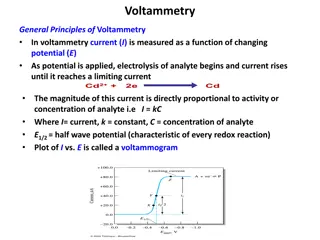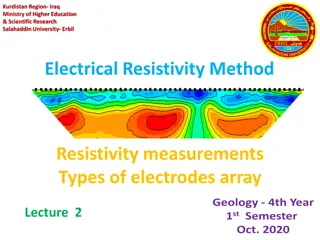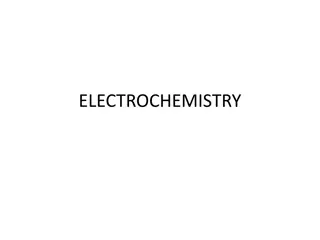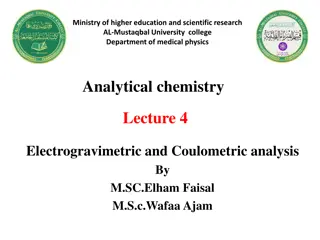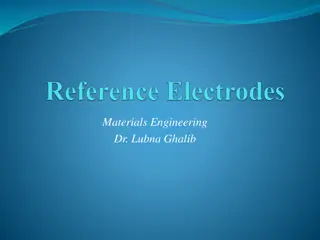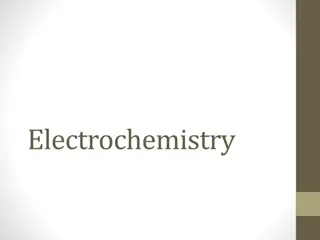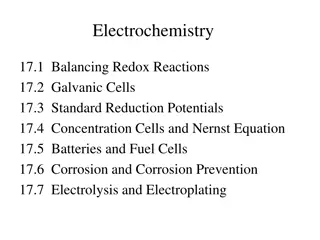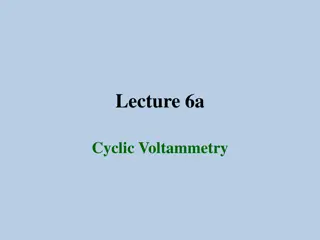Understanding Electrode Reactions in Electrochemistry
Exploring electrode reactions in electrochemistry involves delving into Faraday's law, coulometry, and the importance of sustainable electrode reactions. These concepts help us understand how the quantity of charge passed affects the production or consumption of substances in electrode reactions. As we dive deeper into Faradaic currents, non-faradaic currents, and competing reactions, we uncover essential principles governing electrochemical processes. Additionally, the analysis of reactant species concentration through coulometry and the significance of adequate reactant supply in electrode reactions further enhance our comprehension of electrochemical phenomena.
Download Presentation

Please find below an Image/Link to download the presentation.
The content on the website is provided AS IS for your information and personal use only. It may not be sold, licensed, or shared on other websites without obtaining consent from the author. Download presentation by click this link. If you encounter any issues during the download, it is possible that the publisher has removed the file from their server.
E N D
Presentation Transcript
KJM 3110 Electrochemistry Chapter 7. Electrode reactions 2022
Ch. 6 Recap Activities: Concentrations and partial pressures: After Ch. 6 you must be able to write a Nernst equation for the En (ENernst, OCV) of any half cell or full cell reaction! ISEs utilise potentials over ion selective membranes: And know the similar expression for a voltage over an ion selective membrane (ISE).
Status Till now, we have been introduced to electricity, chemistry and thermodynamics, electrochemical cells and their operating modes, electrolytic cells (electricity to chemical energy) and galvanic cells (chemical energy to electricity). We have started to look at electrodes. We have in Ch. 6 looked at the thermodynamics of electrodes, and ways to describe it in tables and graphs. We have looked at the use of thermodynamics in potentiometric electrodes, in particular ion selective electrodes (ISEs). In Ch. 7 we ll look closer at electrode reactions.
Electrode reactions In chemistry (Ch. 2) one asks the following questions In electrochemistry we may ask the same questions Answers then emerge in electrochemical terms In Ch. 7 Electrode reactions we address the two latter questions
Faradays law What is Faraday s law? The amount (number of moles) of any substance produced or consumed in an electrode reaction is proportional to the quantity of charge passed Michael Faraday, 1832 Faradaic currents Non-faradaic currents: What may be their reasons? Capacitive currents Electronic conduction Competing reactions
Coulometry Coulometry Analysis of concentration ci of a reactant species i in a finite volume V at fixed well- selected voltage The total charge converted is n and vi are the number of electrons and molecules, respectively, involved in the reaction Charge Q is current I integrated over time t: Flowing coulometry Limiting current at given flow and fixed voltage
Reaction General reaction Sign of n signifies cathodic and anodic direction Faraday s law:
A sustainable electrode reaction of study or use must have An adequate supply of reactants Transport (mass transport) An adequate removal of products Sufficient kinetics of the electrode reaction Conductive pathway for ions Supporting electrolyte A potential window where the reaction (R = O + e-) dominates alone Where the electrode in the supporting electrolyte alone is polarized Example: Au in KNO3(aq)
The Butler-Volmer equation Now, the book takes us through a derivation of the BV equation. It is as important as it is difficult, and there are as many versions and understandings as there are uses of it. It is difficult to derive, and many approaches to making it simpler. The book is one. Let us first take a look at the end result - what we will derive. Can we understand it qualitatively and does it make sense even before we do it in more depth?
A closer look at the reaction e- + O or just R Transport may give gradients We differentiate concentrations c of Reduced and Oxidised species in bulk (b) and on the electrode surface (s). cRs cRb cOs cOb
The energy barrier e- + O R Reaction coordinate Gibbs energies Reactant Product At i = 0 (equilibrium) balanced by nFE0 (standard conditions) nFEe (general) Altered by nF(E-Ee)
Kinetics of electrode reaction Butler-Volmer Simplest possible oxidation reaction Butler-Volmer: s = surface b = bulk The net current density is the sum of the positive oxidation and negative reduction currents Which terms do we understand? Which don t we understand?
Kinetics of electrode reaction rate and current For single electron transfer we will now derive the Butler-Volmer equation Reduced species Oxidised species Simplest possible oxidation reaction Netforward oxidation reaction rate = = = ( ) i E ( ) E ( ) E ( ) E [ ( ) E ( )] E Fv Fv Fv F v v net ox rd ox rd Net current density Definition: An anodic current (oxidation) flowing into a WE is positive. Oxidation rate = / 0 ( ) E ( ) E / k k c ox ox R (All potential dependent)
Check What are the units of the variables in the equations on the last slide? What determines kox? Why and how does it vary with E?
Kinetics of electrode reaction - equilibrium Simplest possible oxidation reaction Oxidation rate Reduction rate Substitute into the net current density: At equilibrium (open circuit) we have zero current, and the null voltage, and the surface concentrations become equal to the bulk concentrations: Nernst: becomes
Check What are En (the null, or open circuit, or equilibrium potential) and E (the formal potential) exactly? What is the significance of the prime ( ) throughout here? We have seen that the mass action quotient Q can be expressed by different parameters, like Activity, or concentration Rate constants More? Discuss how this works for normal chemical reactions and for electrochemical reactions.
Kinetics of electrode reaction formal rate constant Simplest possible oxidation reaction Nernst: becomes Similar for any potential:
Kinetics of electrode reaction transfer coefficients Simplest possible oxidation reaction Multiplying with k0 /k0 and dropping (E) Rearrange to Differentiating w.r.t. E: Also called symmetry factors or charge- transfer coefficients
Kinetics of electrode reaction transfer coefficients Simplest possible oxidation reaction Rate constants at open circuit voltage E vs formal open circuit voltage E
Symmetry of the energy barrier Reductive and oxidative transfer coefficients Charge transfer coefficients Symmetry factor
Kinetics of electrode reaction Butler-Volmer Simplest possible oxidation reaction Substitution of Into Yields one version of the Butler-Volmer equation: Alternative:
Forms of the BV equation all provide the same i Relates to the formal potential: Relates to the null potential: Wikipedia: Note the z Note the
Kinetics of electrode reaction Butler-Volmer Simplest possible oxidation reaction Butler-Volmer: = x x lim 2 e e x 0 x At E En, the BV equation linearises to ( n i i E RT F = ) E n Rearranged into charge transfer resistance: ( ) E E RT i F = = n R ct i n
Tafel plot ln|i| or log|i| vs E At large potentials, the oxidation or reduction dominates The current becomes exponentially dependent on E rd = |z| ox = (1- )|z| z = number of electrons
Reaction order Example reaction For reactant A, for reduction, General rate law Curriculum stops after this Eq. 7.40
Summary Ch 7. Electrode reactions Butler-Volmer equation I-E (or I-V or I-U or Butler-Volmer) plot Tafel plot



